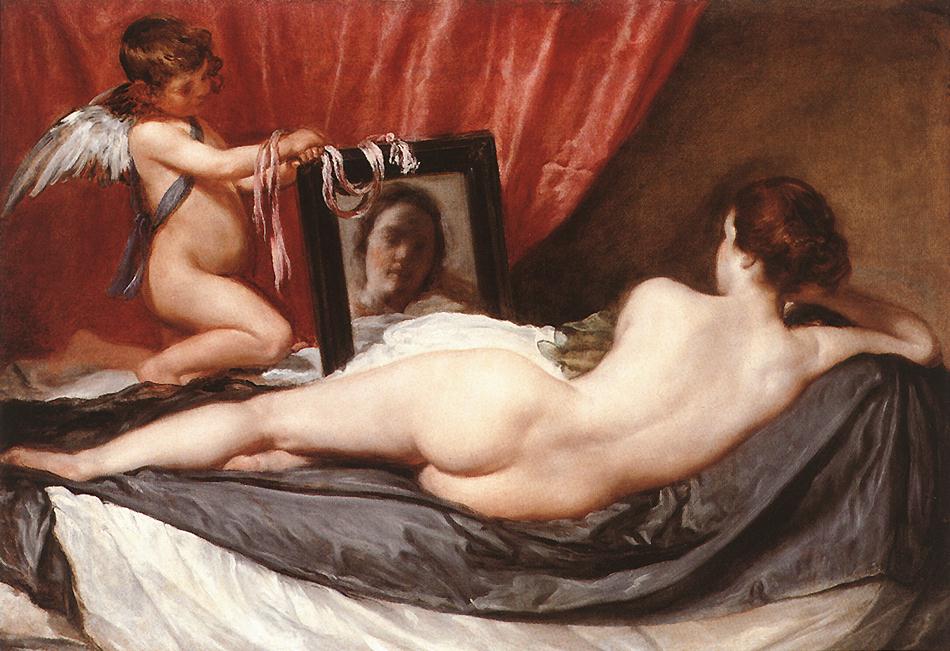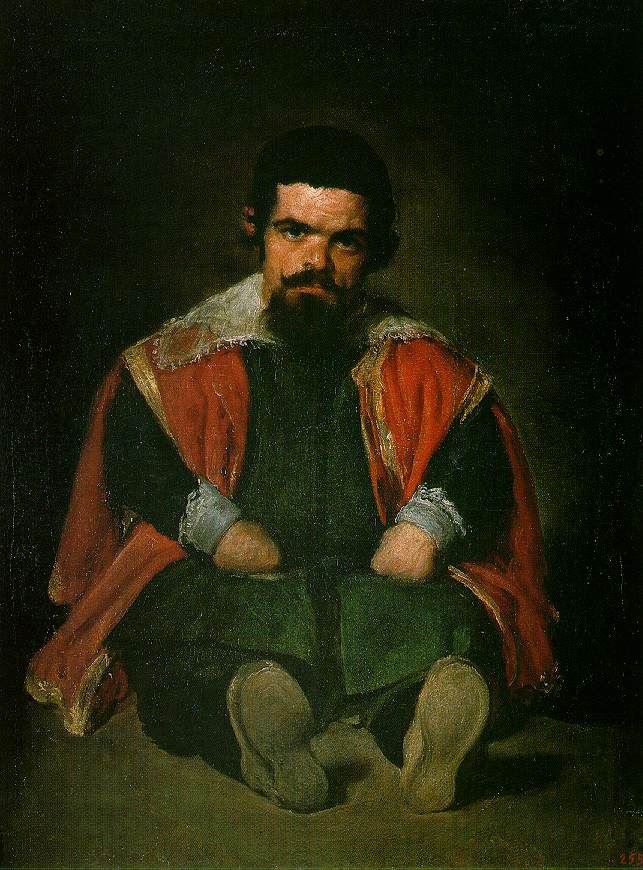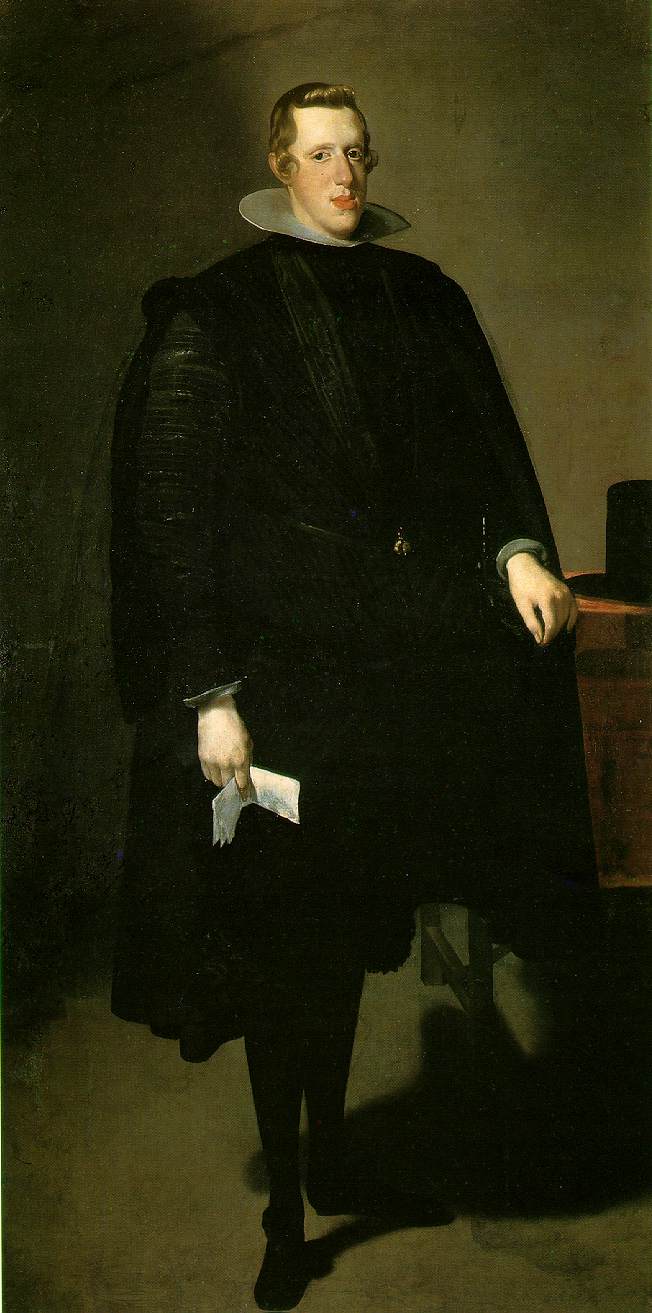
Velazquez Venus: The Toilet of Venus
The Toilet of Venus is also known by the title Venus at her Mirror, as well as The Rokeby Venus, since it was held in Rokeby Hall in Yorkshire for almost a century before being purchased by the National Gallery in London. Life-size in dimension, the painting has sensuality, presence and authenticity that may not have been present had it been smaller. Making the painting even more remarkable, Venus’ face in the mirror is mainly in shadow, as Velázquez omitted the two most expressive aspects of the body – the face and the hands. Another interesting artistic note is that the mirror, standing at that particular angle, should not have reflected the subject’s face, but rather another (less modest) part of the body.
It is a wonder that Velázquez painted anyone in a state of undress, since nudity was disapproved of in mid-seventeenth century Spain. Women’s dress code was so severe that it often included metal plates built into dresses, which ensured that the shape of the breasts was suppressed. For this reason, it is thought that Velázquez painted Toilet of Venus in Italy and that it went straight into the hands of a private collector in Spain, who would have hung it in his bedroom. In 1914, a suffragette entered the National Gallery and hacked the painting to protest the treatment of Emmeline Pankhurst. It was restored in 1965.
Velázquez’ life story can be subtitled “an aspiration to prestige and status.” His parents claimed ties to nobility, which made it surprising that they allowed their son, and particularly their oldest son, to be apprenticed (at age 11) to a painter, since painters in Spain in the 1600’s were thought of as mere craftsmen, rather than as artists. Painters sold their work at low prices and were often employed to do menial tasks. Velázquez eventually married the daughter of Francisco Pacheco, to whom he had been apprenticed.

Velazquez Dwarf: The Dwarf Sebastian de Morra
Velázquez’ chance to climb the status ladder came when his talents were recognized by the young king Philip IV, and he was invited to join the king’s group of painters and live in the palace. From then on, Velázquez’ main subjects were members of the royal family and their entourage. Hence, we see several paintings of dwarfs, who were employed as jesters and entertainers in the court. . Writes Norbert Wolf: “The portraits of the Spanish Habsburgs painted in profusion by Velázquez are surely among the finest and best examples of court portraiture in the history of European art.” (1)
Besides two trips to Italy, Velázquez’ life was tied to that of Philip IV. He has been described as having “only one wife, one friend (the king) and one studio (the palace).” (2) However Velázquez clearly managed to find other interests in Italy where he fathered an illegitimate child.

Velazquez Philip: Philip IV
The flip side of being in Philip IV’s employ was that Velázquez’ productivity was severely hampered as a result of duties, other than painting, that he had to perform in the palace. These included everything from bookkeeping to decorating the palace – all of which left him little time to paint. In total he only painted about 125 pictures, and in the last two decades of his life, when he was particularly tied up with other courtly duties, he only produced two paintings per year on average. It is uncertain whether Velázquez minded that he did not produce more paintings, since the other duties he performed resulted in his heightened status. He was awarded several positions in the palace, including the sought-after aposentador mayor de palacio with which he was honored in 1652. Velázquez was chosen over several other applicants by the king himself.
Velázquez was successful in his quest for an elevated status. He died rather suddenly at the age of 61 and was buried as a nobleman. During his lifetime, his fame fell well short of the Flemish painter, Peter Paul Rubens, who lived at the same time. However, his fame grew steadily after his death, and today he is regarded as one of the most original painters in the history of European art. (3)
Notes:
(1) Velázquez by Norbert Wolf. 1999, Taschen, Cologne, p. 29.
(2) Velázquez by Norbert Wolf. 1999, Taschen, Cologne, p. 77.
(3) Velázquez. TheTtechnique of Genius by Jonathan Brown and Carmen Garrido. 1998, Yale University Press, New Haven and London, p. 21.
Sources:
Velázquez by Norbert Wolf.1999, Taschen, Cologne
Velázquez The Ttechnique of Genius by Jonathan Brown and Carmen Garrido. 1998, Yale University Press, New Haven and London
Venus at her Mirror by Andreas Prater. 2002, Prestel, Germany
The Cambridge Companion to Velázquez edited by Suznne L. Stratton-Pruitt. 2002, Cambridge University Press , UK
Velázquez by Jonathan Brown. 1986, Yale University Press, New Haven and London
